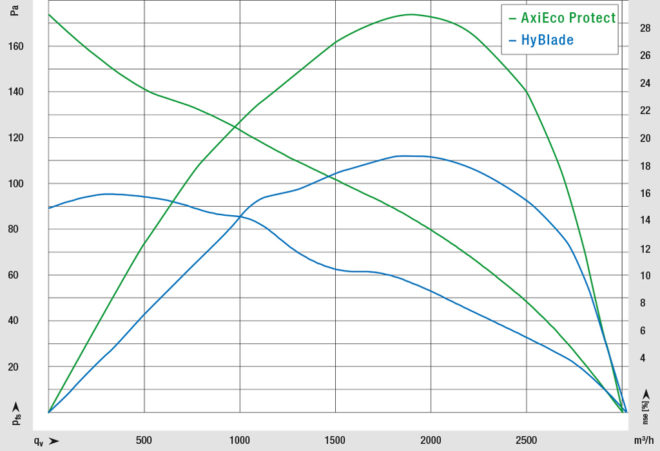Fans function efficiently when their optimal operating range is harmonized with the application’s requirements. Fans in evaporators must overcome high counter-pressure since the ice that often forms on the heat exchanger constricts the air channels. From that point of departure, motor and fan specialist ebm-papst developed AxiEco Protect (Fig. 1), a new axial fan series in both EC and AC technology. It features high efficiency and unusually high stability under pressure.
AxiEco Protect’s air performance curve has a much steeper slope than that of comparable axial fans (Fig. 2). In practical use, this results in several benefits. Even when the counter-pressure is high, the fans function at high efficiency. As a result, even AC designs satisfy the requirements of the future ErP Directive. Manufacturers can now choose the technology upon which they prefer to rely. And service life, the interval between defrost cycles, is also extended. This also saves energy and increases the device’s overall efficiency.

Figure 1: The new AxiEco Protect in EC technology (left) and AC technology (right). (Photo | ebm-papst)
New aerodynamics concept
The key to the increased efficiency and higher pressure increase of AxiEco Protect fans is aerodynamic optimization. For example, the impeller, integrated diffusor ring, and hub form a compact unit and the blade tips seamlessly join the integrated diffusor ring. This eliminates the head gap between nozzle and impeller, also eliminating the blade tip overtopping seen in conventional axial fans. The new design increases efficiency and reduces noise at the same time.
The integrated diffusor ring also functions as a diffuser that is directly integrated into the impeller. It increases the pressure, resulting in reduced exit loss and less noise. Thanks to the inlet ring that immerses in the impeller and a larger outlet opening, the fan has an optimal flow (Fig. 3).

Figure 2: The air performance curve of the AxiEco Protect has a much steeper slope than that of the HyBlade while maintaining the high efficiency level. (Chart | ebm-papst)
Perfectly harmonized to different applications
With many practical design details, the new AxiEco Protect has been optimized for ventilation, refrigeration and air conditioning applications. When used in evaporators or heat pumps, the axial fan series makes both service work and compliance with hygiene rules easier. It will never be possible to fully prevent ice formation on heat exchangers and fans. But it is possible to minimize it, which also extends their service life.
Many users have wished for reduced ice formation, and the developers fulfilled their wish in the new series by applying several measures. The new flow profile of AxiEco Protect fans ensures that guard grills do not ice as quickly. And the impeller with the integrated diffusor ring has been produced in highly resistant plastic, a material that, in and of itself, discourages icing. The fans’ guard grill is made of metal, which means that it is highly robust. The reason for this is that mechanical means are usually employed to remove the ice forming on the grill.

Figure 3: Thanks to its optimal flow conditions, AxiEco Protect continues to function efficiently even when counter-pressure increases. (Illustration | ebm-papst)
Drainage channels on the fan blades ensure that after routine defrosting, melt water can easily drain towards the drip pan provided at the evaporator. They prevent the fan blades from freezing up. At the same time, water is prevented from splashing when the fan is restarted. The more stringent the hygiene requirements, the more important this feature becomes. Splash water must be prevented from contaminating food stored in open containers whenever possible, for example.
The fans come in sizes 300, 350, 400, 450, and 500 and are available in EC and AC design (Fig. 4). With air flows of up to 12,000 m³/h and pressures of up to 450 Pa, they are ideal for a number of typical applications in refrigeration, air conditioning and ventilation technology, and can be used for both pressure and suction. As a compact plug & play solution, they are easily integrated into applications. In the easiest cases, they can be placed on an existing short nozzle.

Figure 4: Air performance curves of the new AxiEco Protect axial fans in EC technology. (Chart | ebm-papst)
The new AxiEco Protect fans satisfy the requirements of the next ErP stage, regardless of the motor technology used. And the fans with EC motors offer many more advantages. In comparison to AC motors, EC motors function with considerably higher efficiency. They also generate less waste heat, an important advantage for chilling applications. Needs-based controls and fan monitoring via 0-10 V signal or MODBUS are also possible.
These features help the EC fans to work very efficiently in the partial-load range as well, and significantly reduce energy consumption. This facilitates individual adaptation to particular cooling requirements. Typical examples include the maturing of cheese and the ripening of sensitive fruit and vegetables in storage, and varying day and night operation. The new features enable needs-based air flow to be easily set in ventilation applications as well. As of fall 2020, an advanced development will allow the robust fans to be used in mechanical engineering alongside additional refrigeration, ventilation and air conditioning applications.

What a great twin fan! I think the anti-freeze feature is excellent.